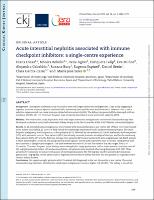| dc.contributor | Vall d'Hebron Barcelona Hospital Campus |
| dc.contributor.author | Oleas, Diana |
| dc.contributor.author | Bolufer Cardona, Monica |
| dc.contributor.author | Agraz Pamplona, Irene |
| dc.contributor.author | Felip Font, Enriqueta |
| dc.contributor.author | Gabaldon Dominguez, Alejandra |
| dc.contributor.author | Bury, Roxana |
| dc.contributor.author | Espinel Garuz, María Eugenia |
| dc.contributor.author | Serón Micas, Daniel |
| dc.contributor.author | García Carro, Clara |
| dc.contributor.author | Soler Romeo, Maria Jose |
| dc.contributor.author | Muñoz Couselo, Eva |
| dc.date.accessioned | 2022-03-22T14:27:06Z |
| dc.date.available | 2022-03-22T14:27:06Z |
| dc.date.issued | 2021-05 |
| dc.identifier.citation | Oleas D, Bolufer M, Agraz I, Felip E, Muñoz E, Gabaldón A, et al. Acute interstitial nephritis associated with immune checkpoint inhibitors: a single-centre experience. Clin Kidney J. 2021 May;14(5):1364–70. |
| dc.identifier.issn | 2048-8513 |
| dc.identifier.uri | https://hdl.handle.net/11351/7240 |
| dc.description | Acute interstitial nephritis; Checkpoint inhibitors; Kidney biopsy |
| dc.description.abstract | Background
Checkpoint inhibitors (CPIs) are used to treat solid organ metastatic malignancies. They act by triggering a vigorous immune response against tumoural cells, preventing their proliferation and metastasis. However, this is not a selective response and can cause immune-related adverse events (irAEs). The kidney can potentially be damaged, with an incidence of irAEs of 1–4%. The most frequent type of toxicity described is acute interstitial nephritis (AIN).
Methods
We conducted a study of patients with solid organ metastatic malignancies treated with immunotherapy who developed acute renal injury and underwent kidney biopsy in the last 14 months at the Vall d’Hebron University Hospital.
Results
In all, 826 solid organ malignancies were treated with immunotherapy in our centre, 125 of them (15.1%) developed acute kidney injury (AKI), 23 (18.4% of AKI) visited the nephrology department and 8 underwent kidney biopsy. The most frequent malignancy was lung cancer, in five patients (62%), followed by two patients (25%) with melanoma and one patient (12%) with pancreatic cancer. Four patients (50%) had already received previous oncological therapy, and for the remaining four patients (50%), CPI was the first-line therapy. Five patients (62%) were treated with anti-programmed cell death protein 1, three patients (37%) received anti-programmed death ligand 1 and two (25%) patients were treated in combination with anti-cytotoxic T-lymphocyte antigen 4. The time between the start of CPI and the onset of the AKI ranged from 2 to 11 months. The most frequent urine findings were subnephrotic-range proteinuria, with a mean protein:creatinine ratio of 544 mg/g (standard deviation 147) and eosinophiluria. All patients were biopsied after being diagnosed with AIN. Three patients (37%) received treatment with pulses of methylprednisolone 250–500 mg/day and five patients (62%) received prednisone 1 mg/kg/day. Seven patients (87%) experienced recovery of kidney function and one patient (12%) progressed to chronic kidney disease.
Conclusions
We report on eight patients with CPI-related AIN diagnosed in the last 14 months at our centre. The novel immunotherapy treatment of metastatic solid organ malignancies carries a higher risk of irAEs. The kidney is one of the most commonly affected organs, frequently presenting as an AIN and exhibiting a favourable response to steroid treatment. |
| dc.language.iso | eng |
| dc.publisher | Oxford University Press |
| dc.relation.ispartofseries | Clinical Kidney Journal;14(5) |
| dc.rights | Attribution-NonCommercial 4.0 International |
| dc.rights.uri | http://creativecommons.org/licenses/by-nc/4.0/ |
| dc.source | Scientia |
| dc.subject | Ronyons - Malalties - Tractament |
| dc.subject | Medicaments antineoplàstics - Ús terapèutic - Efectes secundaris |
| dc.subject.mesh | Nephritis, Interstitial |
| dc.subject.mesh | /drug therapy |
| dc.subject.mesh | Antineoplastic Agents |
| dc.subject.mesh | /adverse effects |
| dc.title | Acute interstitial nephritis associated with immune checkpoint inhibitors: a single-centre experience |
| dc.type | info:eu-repo/semantics/article |
| dc.identifier.doi | 10.1093/ckj/sfaa008 |
| dc.subject.decs | antineoplásicos |
| dc.subject.decs | /efectos adversos |
| dc.subject.decs | nefritis intersticial |
| dc.subject.decs | /farmacoterapia |
| dc.relation.publishversion | https://doi.org/10.1093/ckj/sfaa008 |
| dc.type.version | info:eu-repo/semantics/publishedVersion |
| dc.audience | Professionals |
| dc.contributor.organismes | Institut Català de la Salut |
| dc.contributor.authoraffiliation | [Oleas D, Bolufer M, Agraz I, Bury R, Espinel E, Serón D, García-Carro C, Soler MJ] Servei de Nefrologia, Vall d’Hebron Hospital Universitari, Barcelona, Spain. [Felip E, Muñoz E] Servei d’Oncologia Mèdica, Vall d’Hebron Hospital Universitari, Barcelona, Spain. [Gabaldón A] Servei de Patologia, Vall d’Hebron Hospital Universitari, Barcelona, Spain |
| dc.identifier.pmid | 34221369 |
| dc.identifier.wos | 000651847200009 |
| dc.relation.projectid | info:eu-repo/grantAgreement/ES/PE2013-2016/RD16%2F0009%2F0030 |
| dc.rights.accessrights | info:eu-repo/semantics/openAccess |

